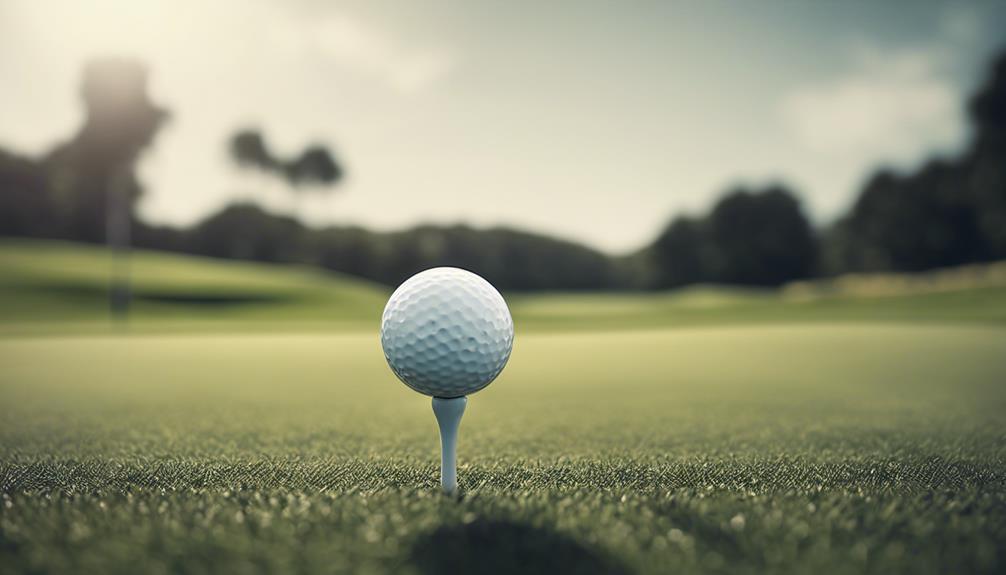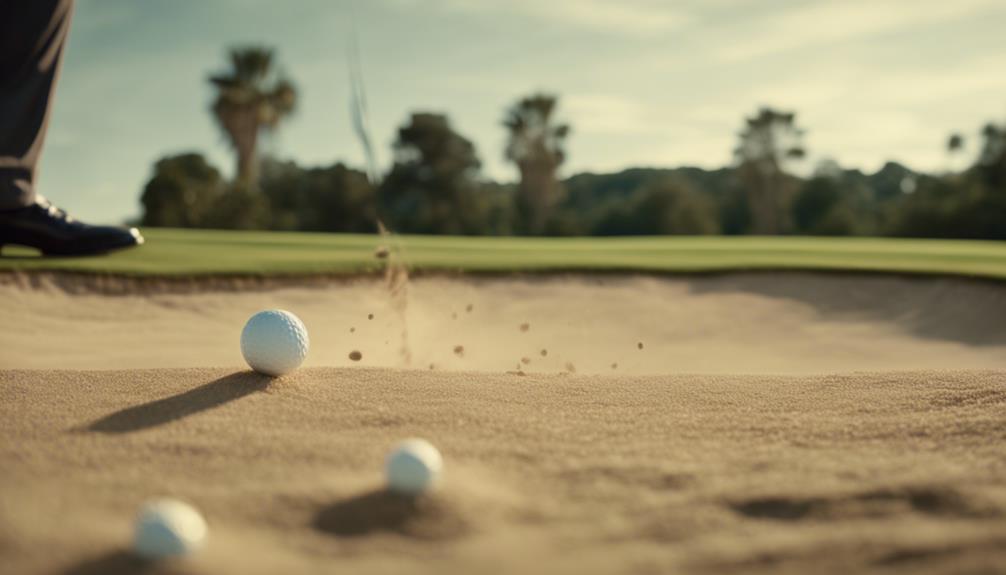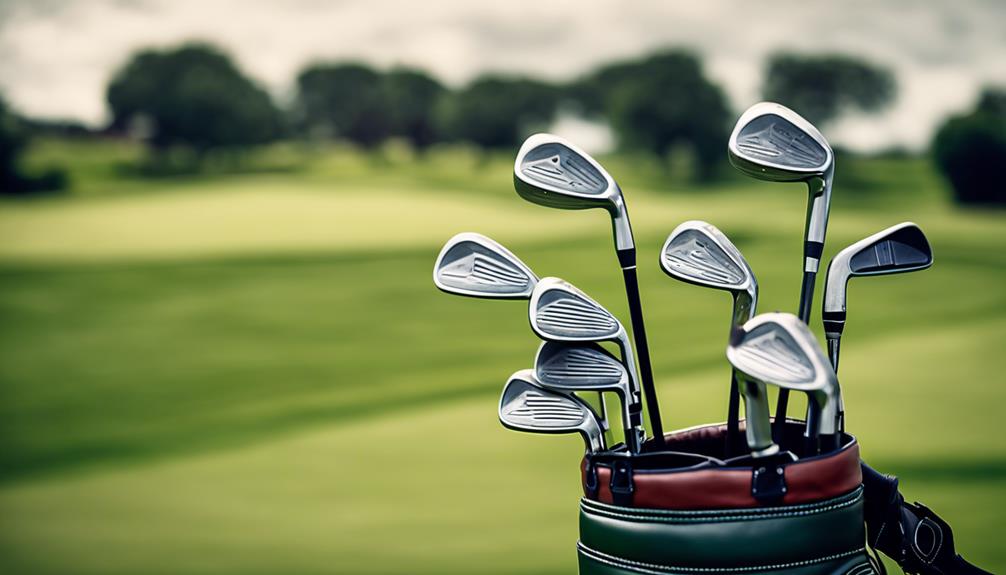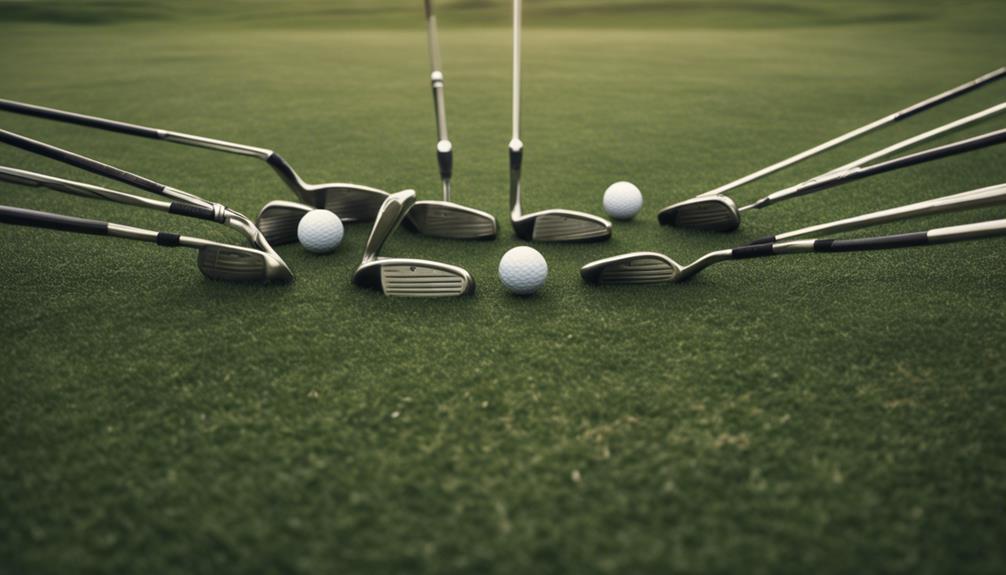- 7 Top Flite Golf Clubs XL for Improved Performance - September 28, 2024
- Top Flite Golf Clubs: Top 5 Reasons to Choose Them - September 28, 2024
- Top 3 Golf Club Fitters for a Perfect Swing - September 28, 2024
You need a well-rounded set of golf clubs, including drivers, woods, hybrids, irons, wedges, and putters, to cater to your strengths and weaknesses and help you develop your skills quickly. Drivers and woods offer maximum distance off the tee, while hybrids combine forgiveness and accuracy. Irons account for nearly 70% of your shots, and mastering iron play fundamentals is essential. Wedges provide high-angle shot options, with four main types for specific uses. By understanding each club type and its capabilities, you'll refine your club selection skills and optimize your game. Now, explore each club type in more depth to elevate your performance.
Key Takeaways
- A beginner set should include a driver, fairway woods, hybrid clubs, irons, wedges, and a putter for a well-rounded golf set.
- Drivers and woods provide maximum distance off the tee, while fairway woods are used for shots from the fairway or rough.
- Hybrid clubs combine forgiveness and accuracy, replacing traditional long irons, and are available in various lofts and lie angles.
- Irons are essential for consistent shots, with long, mid, and short irons each having its distance range and loft angle affecting trajectory and spin.
- Wedges offer high-angle shot options, including pitching, gap, sand, and lob wedges, each with a specific use and loft angle.
Essential Clubs for Beginners
When building your golf bag, focus on including the essential clubs that will help you learn the game efficiently, and a solid foundation for a beginner set consists of a driver, 5 or 7 wood, 6 hybrid, 8 iron, pitching wedge, sand wedge, and putter.
This combination provides a well-rounded golf set that will help you develop your skills quickly.
The 6 hybrid is a great club for beginners, as it's easier to hit than long irons and offers more forgiveness, making it ideal for learning trajectory control.
The 8 iron is essential for shorter shots to the green and for chipping, and it's a great club for learning precise shots.
The pitching wedge is another vital club in your set, as it allows you to hit high, arcing shots onto the green.
With these clubs, you'll be well-equipped to tackle various situations on the course.
Understanding Driver and Woods
Drivers and woods are designed to achieve maximum distance off the tee, with their large, flat clubheads and long shafts working together to generate tremendous power and speed.
As a golfer, you'll rely on these clubs to get the ball flying down the fairway.
Your driver is the longest club in your bag, typically used for tee shots on par-4 and par-5 holes. It's designed to hit the ball as far as possible, often exceeding 200 yards.
Fairway woods, on the other hand, are used for shots from the fairway or rough, typically when you're 150-220 yards from the green. They're smaller than drivers but still pack a punch, allowing you to navigate tight lies and tricky terrain.
When choosing your driver and fairway woods, consider factors like loft, clubhead size, and shaft flexibility to find the perfect fit for your swing.
Hybrid Clubs Explained

Most golfers find hybrid clubs to be a versatile and reliable addition to their bag, offering a unique blend of forgiveness and accuracy that makes them an attractive alternative to traditional long irons and fairway woods. As you consider adding hybrid clubs to your collection, you must understand their design and benefits. Hybrid clubs combine the forgiveness of fairway woods with the accuracy of irons, making them an ideal choice for golfers of all skill levels.
| Characteristic | Hybrid Club |
|---|---|
| Clubhead size | Smaller than fairway wood, larger than iron |
| Shaft length | Shorter than fairway wood, longer than iron |
| Loft and lie angles | Available in various options to suit swing style and preferences |
| Replacement for | Traditional long irons (2-iron to 5-iron) |
Iron Play Fundamentals
Mastering iron play fundamentals is essential to consistently hitting accurate and controlled shots, as irons account for nearly 70% of a golfer's total shots in a round.
To improve your iron play, you need to focus on the proper grip, stance, and swing technique. Understand that the ball position is critical, typically situated slightly back of center in your stance, and adjust it based on the club type and swing style.
You'll benefit from categorizing irons into long, mid, and short irons, each with its distance range and loft angle affecting the ball's trajectory and spin.
Develop a consistent pre-shot routine and alignment to establish a consistent swing plane and face alignment, leading to more accurate shots.
Practice with different iron types and distances to develop a better sense of distance control and trajectory management. This will enable you to make informed club selections and execute shots with confidence.
Wedge Selection and Use

As you move beyond iron play fundamentals, you're likely to encounter situations that require more precision and control, which is where wedges come into play, offering a range of high-angle shot options.
Wedges are specialty irons used for shots that need high spin and control, typically within 100 yards of the green.
There are four main types: pitching wedges (PW), gap wedges (GW), sand wedges (SW), and lob wedges (LW), each with a specific use and loft angle.
The bounce angle of a wedge, ranging from 0 to 20 degrees, affects the club's interaction with the turf and is vital when selecting a wedge.
You'll use the PW for shots from the fairway or rough, while the SW is ideal for shots from sand traps.
The LW, with its high loft angle, is perfect for those delicate, high-arcing shots.
Practicing with wedges can dramatically improve your short game by developing precision and control.
Mastering the Putter
When you're on the green, mastering the putter comes down to precise control over two key elements: putter face alignment and putter path control.
You'll need to guarantee your putter face is square to the target line at impact, and that the putter head is moving smoothly along the intended path.
Putter Face Alignment
Properly aligning the putter face is essential, since it directly influences the direction and roll of the ball, making a square face alignment imperative for executing a straight shot.
As you prepare to putt, focus on aligning the face with the target line, making certain it's square to the direction of the putt.
The loft of your putter, typically between 2-4 degrees, also plays a pivotal role in alignment, affecting the ball's trajectory and roll.
To master putter face alignment, practice using alignment aids like a string or laser to visualize the target line and confirm the face is square.
Develop a consistent pre-shot routine, including a consistent stance, grip, and alignment process, to achieve consistent results.
By doing so, you'll improve your chances of making a straight putt.
Remember, a well-aligned putter face is key to executing a precise and controlled roll.
Putter Path Control
You must control the putter's path to consistently roll the ball on your intended line, making precise adjustments to the putter's direction and speed essential for mastering the short game. A slight deviation from the intended path can result in a missed putt, making it crucial to focus on putter path control.
To achieve optimal control, focus on making contact with the sweet spot of the putter. This will ensure a consistent roll and reduce the likelihood of pushing or pulling the putt. Here's a breakdown of the key factors to consider:
| Putter Path Control | Effect on Roll | Adjustment Required |
|---|---|---|
| Open Face | Pushes ball to the right | Close face slightly |
| Closed Face | Pulls ball to the left | Open face slightly |
| Off-Center Hit | Reduces speed and direction control | Practice sweet spot contact |
Building a Well-Rounded Set

When building a well-rounded set, you'll want to focus on essential club combinations that provide consistent performance across different distances and lies.
A balanced set makeup is vital, and you should aim to create a seamless progression between your hybrids and irons by maintaining consistent loft gaps.
Essential Club Combinations
Building a well-rounded set of golf clubs is essential, and a beginner's set should include a strategic combination of clubs that cater to various shots and distances.
To create a well-rounded set, you'll need a mix of clubs that cover different distances, trajectories, and situations.
A good starting point is to include a driver, 5 or 7 wood, 6 hybrid, 8 iron, pitching wedge, sand wedge, and putter in your set of golf clubs.
The 6 hybrid is a great club to use instead of long irons, as it's easier to hit and provides more forgiveness.
The 8 iron is necessary for shorter shots to the green and for chipping, while the sand wedge is essential for playing out of the sand.
When it comes to the putter, it's a matter of personal preference, so try out different putters to find the one that feels comfortable and suits your putting style.
Balanced Set Makeup
Crafting a balanced set of makeup involves carefully selecting clubs that align with your swing foundation, practice habits, and individual needs, ensuring a well-rounded arsenal for tackling various shots and situations on the course.
As you build your set, consider your swing speed and how it affects the clubs you choose. A balanced set should include a mix of clubs that cater to your strengths and weaknesses.
For beginners, a driver, 5 or 7 wood, 6 hybrid, 8 iron, pitching wedge, sand wedge, and putter provide a solid foundation.
The 6 hybrid is a great alternative to long irons, offering more forgiveness and ease of use.
The 8 iron is essential for shorter shots to the green, while the sand wedge is a must-have for escaping tricky sand traps.
Remember, a putter is a matter of personal preference, so experiment with different options to find the one that suits your style.
Versatile Club Selection
You'll find that selecting the right mix of clubs is key to creating a well-rounded set that prepares you for any situation on the course. A full set should include a driver, woods, hybrids, irons, wedges, and a putter to cover various shot distances and situations.
| Club Type | Recommended Loft Range |
|---|---|
| Hybrid (6) | 22-25 degrees |
| Iron (8) | 37-40 degrees |
| Pitching Wedge | 46-48 degrees |
| Sand Wedge | 54-57 degrees |
| Lob Wedge | 58-64 degrees |
When building your set, consider including a 6 hybrid instead of long irons (3-4-5) as it's easier to hit and provides more forgiveness. An 8 iron is also necessary for shorter shots to the green and for chipping, filling the gap between the hybrid and pitching wedge. Consistent loft gaps between hybrids and irons are essential for choosing the right club. By selecting the right mix of clubs, you'll be well-equipped to handle any situation on the course.
Club Types for Specific Shots
When tackling a round of golf, selecting the right club for a specific shot is crucial, as each club is designed to excel in particular situations and distances.
You need to choose a club that suits the shot you're about to take, considering factors like distance and accuracy.
For instance, drivers are perfect for tee shots on Par 4s and Par 5s, where you need to cover a long distance, typically between 200-400 yards.
Hybrids, on the other hand, are ideal for longer shots out of the rough, offering more forgiveness and a distance range of 150-220 yards.
Irons are your go-to clubs for shots from the fairway or rough, typically within 200 yards of the green, with a distance range of 100-200 yards.
They come in three categories: long irons, mid-irons, and short irons.
Wedges are designed for accuracy and getting close to the green, especially in short distances, providing maximum spin and height, with a distance range of 50-120 yards.
They're categorized into pitching wedges, gap wedges, sand wedges, and lob wedges.
Choosing the Right Club

Selecting the right club from your bag requires a deep understanding of your swing, the shot at hand, and the club's capabilities.
You need to think about the distance, trajectory, and spin required for the shot. To choose the right club, you must assess your swing speed, tempo, and angle of attack. This will help you determine the ideal shaft flex, which can profoundly impact your shot's accuracy and consistency.
When selecting a club, factor in the lie of the ball, the wind direction, and the terrain.
For example, if you're playing from a sandy lie, you may need a club with more loft and a wider sole to help you escape the bunker. Additionally, take into account the club's forgiveness and workability.
If you're a beginner, a more forgiving club with a larger sweet spot may be a better choice. On the other hand, if you're an experienced golfer, you may prefer a club with more workability to shape your shots.
Overcoming Common Mistakes
Common mistakes in club selection can lead to poor shots, and correcting these errors requires a keen understanding of your swing and the club's capabilities.
As you develop your skills, recognize and overcome these mistakes to take your game to the next level.
Common mistakes to avoid:
Misjudging distance: Not accurately estimating the distance to the green can result in choosing the wrong club, leading to shots that fall short or overshoot the target.
Ignoring your swing tempo: Failing to account for your swing tempo can lead to choosing a club that's too fast or too slow for your swing style, resulting in inconsistent shots.
Overlooking club head design: Not understanding the club head design and its limitations can lead to poor shots, especially when playing from uneven lies or tight spots.
Not adjusting for course conditions: Failing to factor in course conditions, such as wind, slope, or terrain, can result in poor shots and higher scores.
Taking Your Game to Next Level

By refining your club selection skills and avoiding common mistakes, you're now poised to take your game to the next level by optimizing your club choices for every shot.
This is where every golfer wants to be – in a position to consistently shoot lower scores and enjoy the game of golf to its fullest.
To achieve this, you need to develop a deep understanding of your clubs' capabilities and limitations.
Study your swing data and analyze your shot patterns to identify areas for improvement.
Practice with purpose, focusing on specific clubs and scenarios to build muscle memory and confidence.
As you progress, you'll start to notice subtle differences in your game, such as more consistent distances, tighter dispersion, and improved accuracy.
Golf Club Maintenance Tips
You invest a significant amount of time and money in your golf clubs, so you must take care of them properly to maintain their performance and extend their lifespan. Proper maintenance is vital to keep your golf clubs performing at their best.
Clean your golf clubs regularly: Use mild soap and water to prevent corrosion and maintain performance.
Remove dirt and debris: Use a soft-bristled brush to clean the clubhead and grooves, preserving the club's condition.
Protect the clubface: Apply a small amount of clubhead oil or silicone spray to prevent rust and corrosion.
Store your golf clubs properly: Keep them in a dry, cool place away from direct sunlight to prevent damage to the grips and shafts.
Proper maintenance is necessary to keep your golf clubs in top condition. By following these simple steps, you can guarantee that your golf clubs will continue to perform at their best.
Frequently Asked Questions
How Many Clubs Do I Actually Need?
When building your golf bag, you'll find you don't need a full 14 clubs; you can get by with 7-10, depending on your personal preference and the courses you play.
How Many Golf Club Types Are There?
You're wondering how many golf club types exist? With the golf club evolution leading to various classification systems, there are over 20 subcategories, including drivers, woods, hybrids, irons, wedges, and putters, each serving a specific purpose in your golf game.
What Woods and Hybrids Do I Need?
"Can you really tame the beast of distance and accuracy? You'll need the right wood selection, leveraging hybrid technology to conquer fairway shots, with a 5-wood for shorter, higher shots and a 3-wood for long, piercing drives."
How Do I Choose Which Golf Club to Use?
You build club confidence by considering your swing style, distance to the green, and shot type, then selecting the right club, and through practice, refining your choices to develop a reliable, high-performing game.
Conclusion
Fine-tune your game with finesse, focusing on flawless fundamentals.
Familiarize yourself with each club's unique features to forge a formidable foundation.
From drivers to wedges, each selection should suit your swing style, ensuring smooth sequences and strategic shots.
By mastering these main club types, you'll marvel at your improved performance, making your way to a more majestic golfing experience.




